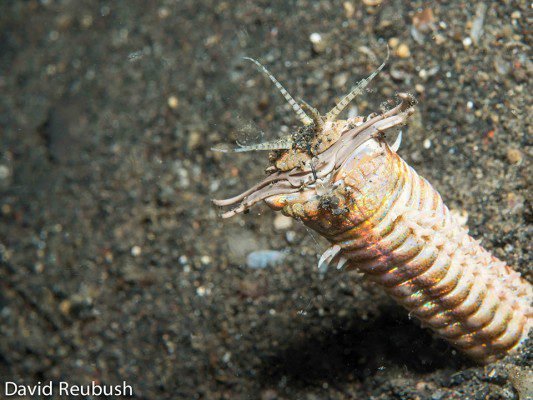
The Bobbit worm, or *Eunice aphroditois*, is known for its long, segmented body and impressive hunting skills. They can grow to impressive lengths and have a bit of a reputation in the aquarium world. On the other hand, cleaner shrimp like *Lysmata amboinensis* play a crucial role in many reef ecosystems, acting as nature’s little cleaners. They help keep larger fish free from parasites—something most fish appreciate! But can these two contrasting characters share the same space? Let’s break it down.
Understanding Bobbit Worms
Bobbit worms are truly unique. They’re not your typical garden variety worm; they can grow up to 10 feet long and have a fierce hunting technique. These worms burrow into the ocean floor, leaving only their colorful, feathery antennae exposed. When unsuspecting prey swims by, the Bobbit worm strikes with lightning speed, using its sharp jaws to capture its meal.
Their homes are often found in sandy or muddy substrates, typically in deeper waters. These worms are nocturnal, which means they do their hunting at night, adding a layer of mystery to their behavior. They thrive in warm waters, often found among coral reefs where there’s plenty of food and hiding spots. However, their aggressive nature can make them a challenging addition to a community tank.
The Feeding Habits of Bobbit Worms
Here’s the thing about Bobbit worms: they’re opportunistic hunters. Their diet mainly consists of small fish, crustaceans, and other invertebrates that might wander too close. When they feel threatened, they can quickly retreat back into their burrow, making it hard for predators—and even curious aquarists—to catch a glimpse of them.
While they can be fascinating to watch, their tendency to snatch up tank mates can create tension in an aquarium setting. If you’re considering adding a Bobbit worm to your tank, it’s important to think about the other creatures that might already be living there.
Introducing Cleaner Shrimp
Cleaner shrimp are often considered the friendly neighborhood helpers of the reef. They’re typically smaller than Bobbit worms and can usually fit in the palm of your hand. The most common species in home aquariums are *Lysmata amboinensis*, known for their bright coloration and social behavior.
These shrimp have a unique symbiotic relationship with many fish. They set up cleaning stations, where various fish come to get rid of parasites and dead skin. Watching a fish relax as a cleaner shrimp works its magic is truly a sight to see. It’s like a spa day for marine life!
How Cleaner Shrimp May Interact With Other Species
Cleaner shrimp are generally peace-loving creatures. They’re not likely to pick fights or cause trouble. Instead, they thrive in busy community tanks, often forming bonds with larger fish. They have a knack for sensing when a fish needs cleaning, and they jump right into action.
But it’s essential to note that their small size also makes them vulnerable. Larger, more aggressive tank mates might see them as snacks, especially in a mixed-species tank. It’s crucial to understand the dynamics in your aquarium to ensure that everyone can coexist without significant stress.
Can They Coexist?
Now for the million-dollar question: can Bobbit worms coexist with cleaner shrimp? The answer is a bit tricky. While both species thrive in similar environments, their behaviors and dietary needs make them unlikely roommates. Bobbit worms are predatory, meaning they see smaller creatures like cleaner shrimp as potential meals.
If you’re thinking about adding both of these fascinating creatures to your aquarium, it’s essential to consider tank size, habitat, and the personalities of each species. Ideally, if you want to keep Bobbit worms, it’s best to avoid including smaller shrimp in the same tank.
Setting Up a Suitable Environment
If you decide to keep Bobbit worms, consider tank conditions that suit their needs while also ensuring the safety of your other tank mates. Here are some tips for setting up a harmonious aquarium environment:
- Tank Size: A larger tank can help create more space for both species, but be cautious with mixing.
- Shelving and Hiding Spots: Bobbit worms prefer sandy bottoms, while cleaner shrimp like nooks and crannies to hide in.
- Water Quality: Both species appreciate clean, well-aerated water, so keep your filtration systems optimized.
Creating a balanced tank environment is crucial for the happiness and health of all your aquatic pets.
Alternatives and Considerations
If you’re eager to have both cleaner shrimp and a vibrant aquarium community, consider alternatives to Bobbit worms. There are many other fascinating invertebrates that cohabitate well with cleaner shrimp. For example, fireworms, which are also striking and colorful, might provide a beautiful alternative without the predatory nature.
Choosing tank mates involves understanding their behaviors, dietary needs, and how they interact. You want to create a peaceful community where each species feels secure.
Final Thoughts on Coexistence
In summary, while Bobbit worms and cleaner shrimp may seem like an interesting pairing, their drastic differences in behavior and dietary needs likely prevent them from peacefully coexisting in the same tank. If you’re passionate about keeping Bobbit worms, consider a more species-specific tank where these captivating creatures can thrive without being a threat to others.
Ultimately, your goal as an aquarist should be to create an environment that’s both beautiful and safe for all your aquatic life. So, whether you go for the Bobbit worm or the friendly cleaner shrimp, just make sure your choices lead to a happy, thriving aquarium!
